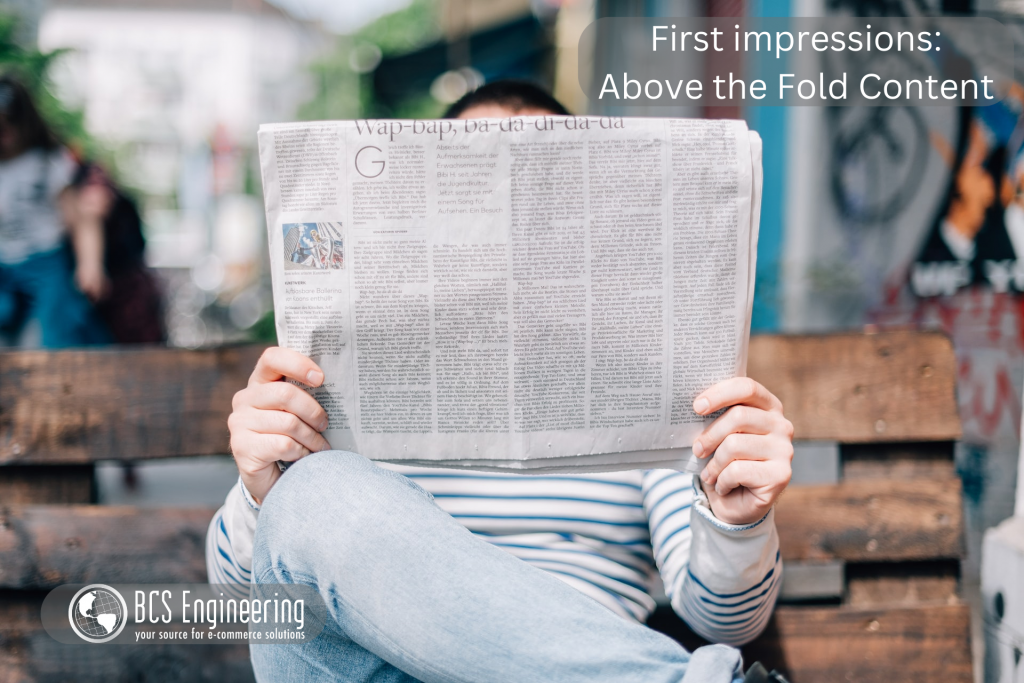In previous articles, we have dived into many ways you can improve user experience on your website. From optimizing SEO for better rank to using Google analytics tools to understand your users better, improving user experience is a site wide endeavor. However, one aspect of your site that may need work is the first thing your users ever see: you “above the fold” content.

What does Above the Fold Mean?
Above the fold is a concept that stems from newspapers. Newspapers are chalked full of interesting content, but getting people to open them up to read that content can be a challenge. Thus, newspapers are set up in such a way that their most interesting headlines are visible from their bin. For people walking by, those headlines may pique their interest enough to buy a newspaper and read the rest of the articles inside.
The same concept can be applied to your website. In the case of the internet, your “above the fold” content is the content visitors see first without the need to scroll.
Why is Above the Fold Content Important?
Just like with our newspaper example, above the fold content is important to optimize for the sake of first impressions. If the first part of your page does not catch your user’s interest, they may leave without scrolling or clicking further. Adjusting your above the fold content is necessary to begin the process of turning visitors into customers.
How do I Improve my Above the Fold Content?
There are many ways you can start making your above the fold content more attractive and engaging.
Make sure your headline is understandable and compelling
Usually, above the fold content involves information that explains who you are and what you do. While the structure of above the fold content may vary per site, most have some sort of headline that aims to capture the attention of visitors. This headline, which will most likely be the first thing that draws the user’s eye, needs to express your purpose and expertise quickly and clearly. What is your specialty? What makes your company different from others? Answering these questions immediately will help the user determine if they are in the right place, or if they are looking for a different solution.
Note: Keep your Audience in Mind
Especially when creating your above the fold content, it helps to keep your target audience in mind. Who are you trying to sell to? What are those users looking for? What are the problems they are trying to solve? Keeping your ideal user in mind can help in creating the perfect above the fold content.
Create a Powerful Call to Action
After the user understands what your company offers, your above the fold content needs to guide them to their next step. This could be as simple as a “Shop Now” Button that will easily bring users to your products. Making sure this call to action is obvious and clear is important to making it simple for an interested user to explore your content further. After all, even if a user finds your above the fold content interesting, there is always the chance that they will not scroll further.
Keep your Imagery Simple
While we can go all out in beautifying our above the fold content, keep in mind that too much content can be distracting. Backgrounds, images, and videos are all great content to share, but having all of them at once can overwhelm your potential customer and cause them to leave. A good rule of thumb is to share a glimpse of your best media and content in your above the fold content. One quality piece of media can really help persuade your users to give your company a chance.
Note: Page Speed can be affected by large media
In previous articles, we have explored how page speed impacts user experience greatly, so it is important to keep in mind the speed of which your above the fold content loads. Make sure the media you use to create your best first impression doesn’t negatively impact your page speed. If the users can’t quickly see your content, they may not stay long enough to consume it.
Want to Learn More about Optimizing your Website?
Above the fold content is just one piece that we can improve to optimize user experience and conversion rates. What other aspects of our sites can we improve to make our website work for us? Carrie Saunders’ upcoming course, “The Converting Website,” will dive into the tools and techniques your can use optimize your website for higher conversion rates. Join the waitlist today to stay up to date on the classes release!
